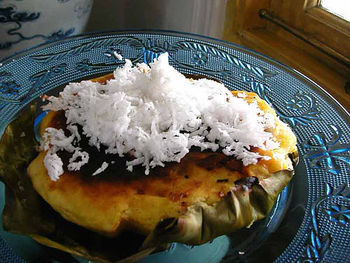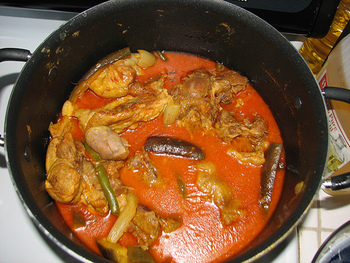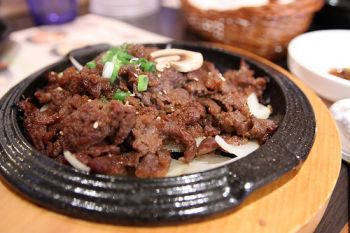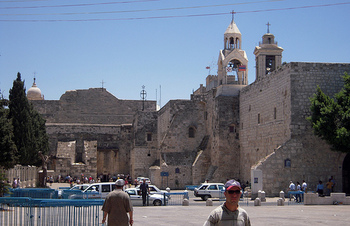Christmas in Asia
Christianity is the predominant religion in only two Asian countries - the Philippines and East Timor. Christians make higher percentage of total population in Lebanon and South Korea. Still, Christmas is a very popular holiday all over Asia.
The most popular Christmas decoration in the Philippines is "pah-role." It is a bamboo pole with lighted star on top of it. This pole represents the guiding star of Bethlehem. People also decorate their homes with buntings, candles and wreaths. Numerous Christmas cards are put in the living room for everyone to see. Cities shine in colourful lights.
 Bibingka
Bibingka
Christmas season in the Philippines starts on the 16th December with the first of nine early morning masses. People do not sleep in the night between Christmas Eve and Christmas Day. The feast on Christmas Eve ("Noche Buena") starts after midnight. It is difficult to properly describe the abundance of Christmas meal in the Philippines. Here are just some of dishes often consumed as part of the meal - "bibingka" (type of pudding), "puto bungbong" (snack made from sticky rice), "kare-kare" (oxtail stew in peanut butter sauce), "rellenong manok" (baked stuffed chicken) etc.
 Kare-kare stew
Kare-kare stew
The center of family Christmas celebration in the Philippines is "lola." Lola is an elder family member, grandparent who is highly respected in every Filipino family. Children line up in front of this person and he or she gives them some coins. Elder child gets more coins than the younger one. On Christmas Day children visit their aunts, uncles, godmothers and godfathers. There they get some money, sweets or little toys.
Only about 2% of Japanese people are Christians. Nevertheless, Christmas in its commercial form is very popular. On Christmas many people eat what they call "Christmas cake." Christmas cake in Japan is a sponge cake with whipped cream and some fruit as toppings. Japanese lovers think that being together on Christmas is especially beautiful. Christmas presents are usually exchanged between lovers or close friends.
During Christmas season you may often hear the 9th Symphony composed by Ludwig van Beethoven (1770-1827). The Japanese call it the “Daiku” or “Great Nine”. The illuminated Christmas tree made from 3,795 champagne glasses can be seen in Tokyo.
Many Japanese cities have wonderful Christmas illuminations. They are set sometime in November. They are removed around Christmas or New Year. There are cases where such illuminations are left until Valentine's Day.
The Japanese do not have Santa Claus or Saint Nicholas. But, they do have a person called "Hoteiosho". He is described as an old man carrying a big sack. It is believed that he has eyes in the back of his head. That is why children have to be good when Hoteiosho is around.
Santa or "Santa Haraboji" is very popular among children in Korea. What differs him from Santas you all know is the fact that in Korea he wears red and blue clothes. Christmas meal in Korea includes traditional Korean dishes like sweet potato noodles, "bulgogi" (barbecued beef), rice cake soup and ”kimchi” ("gimchi").
 Bulgogi
Bulgogi
Vietnamese Christians attend the Midnight Mass. Then they have a special Christmas meal. The most popular dishes prepared for the occasion are chicken soup, turkey and pudding. On Christmas Eve local kids put their shoes outside. They believe that Santa Claus will bring them some presents.
Christians in India decorate a mango or banana tree. Mango leaves are sometimes used as home Christmas decorations. In the south of India people put small clay lamps on flat roofs of their homes. Light of these lamps symbolically shows other people that Christ is the light of the world.
In Mumbai local Christians often put a Nativity scene in their windows for everyone to see. Big hanging star-shaped paper lanterns are also very popular. Christians of the Bhil people who live in the north-west India just love to sing Christmas carols. For a whole week during Christmas season they go from village to village singing Christmas carols.
Bethlehem ("house of bread") is a town in Israel where Christ was born. About 1.9% of Israelis are Christians. On Christmas Eve there are big parades through the town. As result of British occupation between 1920 and 1948 playing bagpipes is quite common in such parades. Santa Claus often appears too. He gives sweets to children passing by.
 Church of the Nativity in Bethlehem
Church of the Nativity in Bethlehem
The most famous part of Christmas in Bethlehem is the Mass of Nativity. It held in the Church of the Nativity in the afternoon, evening and at midnight of Christmas Eve. The mass is held by the Roman Catholic Bishop of Jerusalem. The church was built, around 500 AD, over a place where it is believed that Christ was born. The church is managed by the Roman Catholic Church, the Greek Orthodox Church and the Armenian Apostolic Church.
On Christmas Eve members of Syrian Christian family stand around bonfire with a lit candle in their hands. The youngest child or son of the family reads the Christmas story from the Bible. Immediately after the reading is over bonfire is lit. People believe that flame predict what is going to happen with the family in the coming year. The Psalms are sung. As soon as the flame dies out family members jump on the ashes three times and make wishes.
In the early hours of Christmas a special mass is held in a local church. In the middle of church floor one more bonfire is lit. A member of the local clergy carries a figure of baby Jesus around the church. The nearest person touches the figure and gives it to next one. This is done until everyone touches the figure and that way gets the "Touch of Piece".
Christmas meal in Syria includes chicken, oranges, nuts and different sweets. Children in Syria get presents on the New Year's Day. It is believed that presents are brought by the youngest camel that carried the Magi to Bethlehem. That is why children leave some hay and water next to their house. In the morning of New Year's Day children run outside. Instead of hay and water they left the day before they find presents.
Different Christian churches make about 40% of population in Lebanon. You can read about Lebanese Christmas in the article Lebanese traditions existing on this web site.